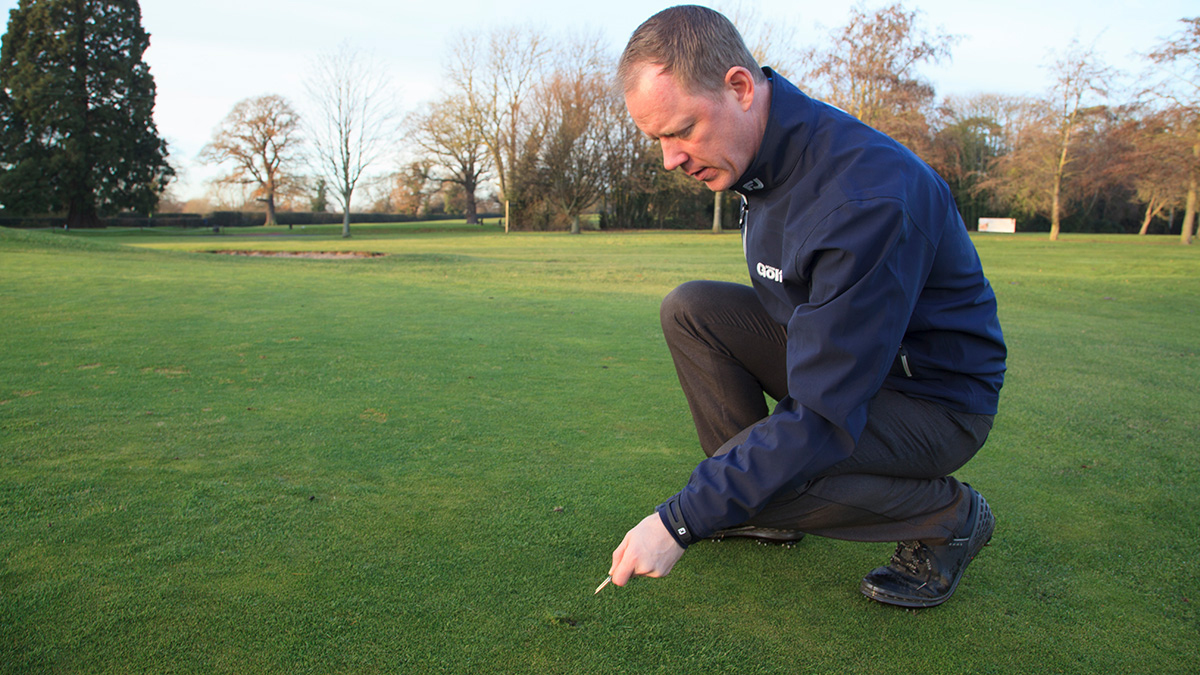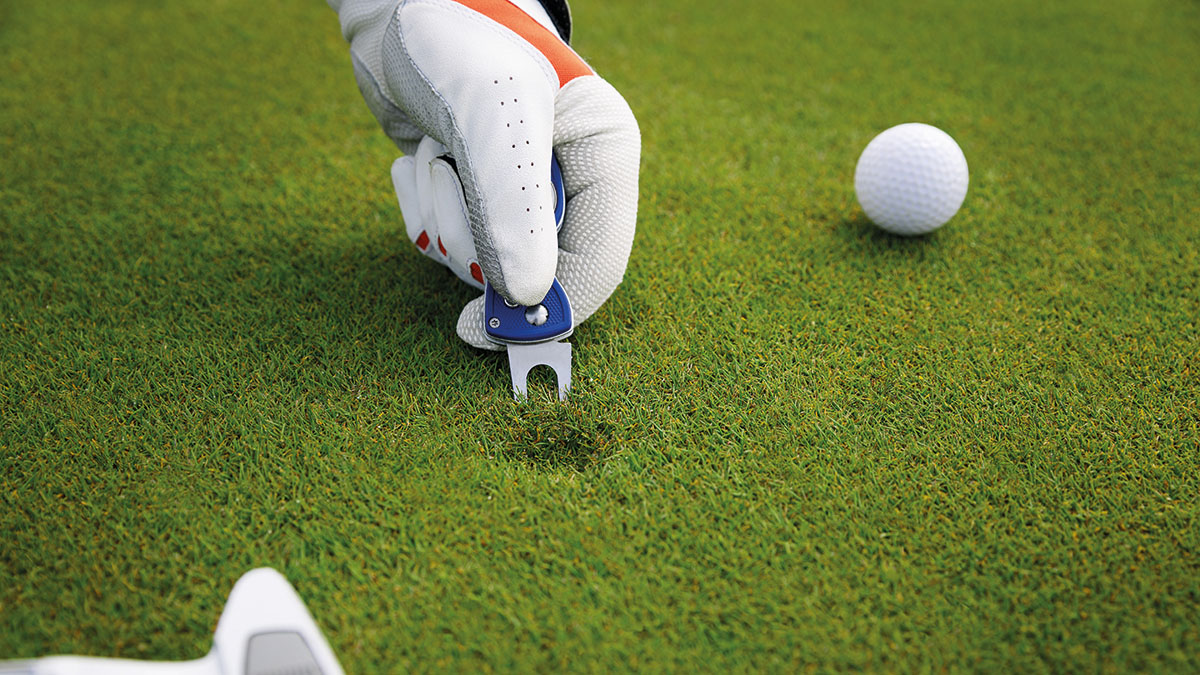- Homepage
- News and Features
- What impact does a pitch mark have on putting surfaces?
What impact does a pitch mark have on putting surfaces?
This article was featured in the Spring 2019 edition of Your Course magazine
They are golf’s equivalent of potholes, but convincing golfers to repair their pitch marks seems as elusive a task as ever. Why is something so simple also so important?

They drive greenkeepers to distraction – something everyone complains about but no one appears able to solve. Golfers and greenkeepers get equally upset when they see a putting surface covered in pitch marks and yet standards of green etiquette seem to be getting worse rather than better.
Everyone knows they should be repaired, but it’s a fair bet if you walk on any green at any course you’ll find plenty of craters where the impact of a shot has been left uncorrected. So what really is the impact of pitch marks? What effect do they have on the way greenkeepers can work and what happens from a turf point of view when golfers leave them unrepaired?
We’ve asked a greenkeeper at one of Britain’s top courses and a BIGGA expert to give us the low down.

Jamie Wade
Head Greenkeeper, the Brabazon at The Belfry
BIGGA: You have three courses at The Belfry, which are all getting an awful lot of play…
Jamie: Last year we came very close to doing 110,000 rounds. We very rarely have an empty golf course – pretty much every tee time is sold. You can imagine the amount of play we get every single day and all year round.
We have no temporary greens and we try to deliver a Ryder Cup experience every day. People come to The Belfry and want good greens, so that is what we try and deliver.
110,000 rounds is an awful lot of balls landing on greens. How many pitch marks would your team be dealing with daily?
We’ve got a team of 40 guys and whatever job we are doing on greens, we have to repair pitch marks every single day. If it’s a particular day when they are not repaired very well, we could be doing up to 30 a green. We shouldn’t be doing those numbers, really. It’s very time consuming for our guys and it slows down our daily maintenance tasks – cutting greens and that kind of work. It’s quite a big job but, even if we are walking past a green and see a pitch mark, the team is encouraged to repair them.
How long would that process take?
It’s hard to say because it’s not an individual job to do them. The fact we do them every single day, without fail, means we are always keeping on top of them.
Does it feel like Groundhog Day?
Definitely. On the Brabazon it takes five hours to mow greens. It would obviously be a far quicker task if we didn’t have to repair pitch marks. You can spend 15 minutes on each green just repairing them.
You’re trying to keep greens at championship condition at all times – how do pitch marks hinder you in that task?
It’s a massive task and it puts a lot of pressure on the team. It doesn’t just affect the guys that are cutting greens but those all the way down.
If golfers repair them wrongly, we have to go out and sand and seed and try and encourage some grasses back in there. That’s another task we shouldn’t have to do, but we want the turf quality of those greens to be 100 per cent.
Can pitch marks affect other areas of green maintenance – such as where you might consider placing a hole?
We don’t put freshly cut pins around disease or any old plugs that we’ve had previously. We are looking for a completely clean area but if a pitch mark is not repaired properly then it is obviously a struggle.
Our greens total a hectare in size. That’s not a massive area compared to some and they might have five or six more pin placements than we might have.
If you could make a plea to golfers about pitch marks, what would it be?
It would obviously be to repair them but I think we still need to educate people better. We encourage our golf operations team to tell golfers before they go out to repair their pitch marks. We’ve also got signage out on the course as well.
The science behind pitch marks

BIGGA’s resident expert explains what happens when a pitch mark occurs and why anything but a prompt repair can cause various problems.
We see the result of a pitch mark when it lands but what it that actually doing to the green?
When the ball impacts the turf it is basically breaking through the canopy and smashing into the soil. As the ball hits, it forces the roots and the shoots of the grass out of the way. How firm or wet the surface is will dictate the severity of the damage. Generally, you want a firmer surface so there is more resilience in the turf to resist the ball making a mark.
It’s not just a little bruise then?
When ball impacts, it generally doesn’t do so on a vertical trajectory – it comes in at an angle. So your pitch mark gets longer and, if that happens, it pushes the turf away.
When it comes to repairing a pitch mark, one of the reasons people do it wrong is they put the repairer in and then lift up. That’s not what you should do.
You actually want to put the pitch repairer in and push from the top and sides – pushing the turf back into the middle of the pitch mark.
It’s like taking a divot, you want to put the turf back into the hole where it has come from.
What happens to a pitch mark if it is not repaired promptly?
If you repair a pitch mark immediately it will start to recover within 24 hours and the damage will clear a lot quicker, depending on how firm the surface is at the time.
In a normal growing period, if you don’t do it within 24 hours then it won’t repair itself for over three weeks. Once that ball has gone in and ripped out those roots, you’ve got to try and get that grass to re-establish in that space.
It will take time and it opens the surface up to weed seeds coming in. Pests will also see an opportunity to get into the soil, so it’s quite damaging.
What can greenkeepers do when they come in on a Monday morning and a green looks like the surface of the moon?
You can’t do much. IF you have the manpower, you’d go and repair all the pitch marks each day but nine clubs out of 10 don’t have that luxury. It really doesn’t take a lot for a golfer to repair a pitch mark.
You don’t want to be hitting your ball up to the hole and it suddenly deviates because there’s a damaged bit of turf because of unrepaired pitch marks.
If damaged pitch marks are not repaired it also makes it very difficult to change holes. When we come to change a hole on a green, we are looking for at least a metre of good clear turf around that hole, free from damage or scars. You want a good, clear area so you have a nice surface to putt on.
If we don’t repair our pitch marks it limits where you can put the holes on putting greens. It becomes even harder for the greenkeeper and even more difficult for the golfer.
The five steps to repairing a pitch mark correctly
1. Discard any loose pieces of turf taken out by the ball
2. Insert the pitch mark repairer tool just outside of the back of the pitch mark
3. Lever the turf towards the centre of the pitch mark
4. Repeat this motion from all sides of the pitch mark
5. Gently tap the repaired area with your putter. This action stretches undamaged turf over the pitch mark, providing instant recovery
Tags
Author

